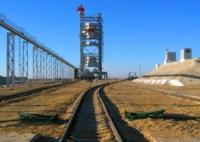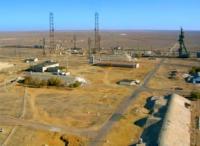You are here
Rocket and space complex "Proton".


Space complexes at Baikonur cosmodrome.
“I see the Earth!..I can distinguish the folds of the terrain, the snow, the forest...I observe the clouds...It’s beautiful. Beauty!"
Yuri Gagarin.
Visit to Proton Rocket and Space Center.
The Proton launch took place on July 16, 1965. Now the number of launches exceeds 250, of which only 11 ended unsuccessfully. Preparation of launch vehicles, upper stages and spacecraft for launch is carried out at technical positions, which are located in four installation and testing buildings.
Technical positions are equipped with special technological and general technical equipment, access roads and utilities. They are designed to receive launch vehicles and payloads from manufacturing plants, store, assemble and test them.
Here, spacecraft are refueled with propellant components and compressed gases, and payloads are docked to launch vehicles. The installation and testing building of the Proton launch vehicle is a unique structure, consisting of the actual installation and testing hall with an area of more than 1,500 square meters and many office premises with control rooms, control rooms, laboratories and other services.
The Proton rocket and space complex is one of the main ones at the Baikonur Cosmodrome.
Thanks to the progressive scientific and technical solutions incorporated into it, this complex in terms of its reliability and many other indicators is the best in the world among launch systems of a similar class. “Flights of automatic interplanetary stations with landings of vehicles on the Moon, Venus and Mars, as well as launches of long-term orbital stations Salyut and Mir, communications and television broadcasting satellites into geostationary orbit are carried out using the Proton complex.
The complex was created on the basis of a three-stage rocket - the Proton carrier, having a length of 44.3 meters and a maximum cross-section of 7.4 meters. At the surface of the earth, its engines develop a thrust of 900 tons.
The rocket is capable of launching a payload weighing up to 20 tons into a reference orbit, and when using an upper stage, a satellite weighing up to 3.5 tons into geostationary orbit. First launch Proton launch vehicles are launched from two launch pads, each of which has two launch positions, a command post, fuel and oxidizer storage facilities, refrigeration centers, high-voltage substations and other infrastructure facilities.
In 1996, Proton was the first domestic launch vehicle to enter the global market for commercial spacecraft launch services, and is marketed by International Launch Services. During its operation, the rocket was repeatedly improved. Now the next stage of its modernization is ending.
The new Proton-M will have a more advanced control system. Environmental pollution from fuel residues in the areas where spent stages fall will be reduced. It is expected that operation of the modernized complex will begin in early 2001.
Geographic coordinates of Proton rocket and space complex, site No. 200: N46°02'23.17" E63°01'54.56"
Note:
If you are using geographic coordinates for the Google Earth or Google Maps navigation systems, you must remove the last two digits from the geographic coordinates and " (hundredths of seconds) and enter the result in the input line. Example: N51°44'09.67" E72°39'40.81" = N51°44'09 E72°39'40
Authority and photos by
http://ruscosmos.narod.ru/KA/glavnaia/Rak_nos/zenit.htm







